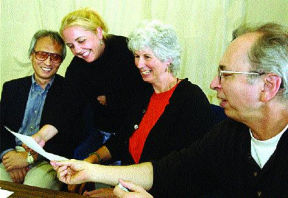
|
|
Noh plays about Steveston? |
||||||
Staff Reporter The little hamlet of Steveston is being accorded an unusual honour-its post-war self is starring in a new Japanese-style play written by a B.C. poet and choreographed by an American ex-pat Noh master. Entitled The Gull: The Steveston Noh Project, it's likely the first English-language Noh play about Richmond. The story centres on two brothers who, in 1950, try to return to the fishing business once taken away from their parents during wartime internment. The project is the brain child of Heidi Specht, artistic director of the Pangaea Arts Society, a Vancouver theatre company that produces multi-cultural plays such as last year's Butterfly Dream at Gateway Theatre. "A lot of Noh plays have ghosts and fishermen-and of course, this connects to Steveston," she says of the traditional style of Japanese theatre. When The Richmond Review caught up with Specht, she had just finished auditioning actors at the Gateway Theatre along with collaborators Richard Emmert, Daphne Marlatt and Toyoshi Yoshihara. The room hums with creative energy-something they'll need to bring this ambitious project to the stage, as many of the performers will need special Noh training. Asked why she chose to create a Noh play, Specht says she's been fascinated with the art form since she took classes years ago from Emmert, the director of Theatre Noh Gaku in Tokyo, Japan. "One woman I met who took the Noh workshop said Noh changed the way she thought about theatre. It expands our potential for experience of art and the world, and I think that's exactly what we want to do," Specht says. "The first time I saw Noh in Tokyo, I was riveted. It was so slow, yet intense. I wondered how did they do it? I had almost a visceral response to it, it just grabbed me." Quiet intensity is the hallmark of Noh, says Emmert, The Gull's director and an American who moved to Japan in 1973. Besides directing a company of English-speaking Noh performers in Tokyo, he teaches Asian theatre and music at Musashino University in Tokyo. Emmert says there's nothing quite like Noh in the Western tradition, as the Japanese art form combines all the performing arts-dance, theatre, music and singing. "Dancers are not thought of as actors, we have them divided. In the East...they bring all these elements together." The Gull will also have Japanese musicians performing Noh music, as well performances from the celebrated Japanese Noh actor Akita Matsui. Although the play will be presented in English, Toyoshi Yoshihara (who runs Maple Leaf Theatre) will translate Marlatt's Noh script for Japanese audiences. Marlatt wasn't the writer who Specht initially thought of when she first dreamt up the idea for The Gull. Instead, she called the celebrated author Joy Kogawa. "But (Kogawa) said, 'Call Daphne Marlatt,'" Specht says. "Noh is a very poetic form of writing and she fit perfectly." Marlatt, who was born in Australia and then moved to Vancouver in 1970, is a writer, teacher and poet with a local interest. One of her published, non-fiction works is Steveston Recollected: a Japanese-Canadian History (1975). "What's interesting to me about Noh is that it's different from the tradition of realism which is so strong in the West," Marlatt says. "Noh works through poetry and symbolism, it embraces nature." Emmert agrees, noting the art form is not overly concerned with plot-as opposed to Western theatre. "Instead it's about being concerned with mood." Typically, the first act in a Noh play involves a mysterious person, someone who is not easy to identify. In The Gull, two brothers experience meeting a different being at the same time. One brother sees a gull, the other sees a female ghost. The mystery slowly unravels through the play, revealing who the ghost is in the second half of the production. Marlatt says that Noh theatre is psychological-that audiences must take a more active role in receiving the story. "Noh requires you to think." The story is about Steveston, however, so the collaborators agree that the story will generate local interest-although Emmert says an appreciation of Noh takes time. "Noh is not such an easy art form. We're not just offering straight entertainment; if you wanted to go to a movie, and just any movie would do, this may not be the thing for you." Noh can be very powerful, Yoshihara notes, particularly when expressing emotional subjects-such as what happened to the Steveston Japanese community during the Second World War internment. "So many people are so angry, but do not express it. Noh is the best way to express quiet anger, which is why I am interested in this particular project. The style and subject perfectly match," he says. In the meantime, Specht says The Gull's team will be focussing on training the local artists appearing in the play. A staged reading at the Gulf of Georgia Cannery is planned for April but no performance dates are scheduled, yet. "It's a very expensive project," she says. "And it's still in the early stages." |
© Copyright 2004 Richmond Review
